Francis Skidmore
| Francis Skidmore | |
|---|---|
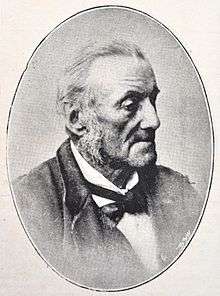 Francis Skidmore | |
| Born |
1817 Birmingham, UK |
| Died |
13 November 1896 Coventry, UK |
| Notable work | Lichfield, Hereford and Salisbury Cathedral screens |
Francis Alfred Skidmore (1817 – 13 November 1896) was a British metalworker best known for high-profile commissions, including the glass and metal roof of the Oxford University Museum of Natural History (1859), the Hereford Cathedral choir screen (1862) and the Albert Memorial (1866–73) in London. Skidmore was heavily influenced by Gothic Revival style, a movement characterised by its use of medieval designs and styles. He was a member of both the Oxford Architectural Society and the Ecclesiological Society, two organisations which endorsed the Gothic Revival style. Skidmore also worked closely with architect Sir George Gilbert Scott.[1]
Early life and work
Francis Alfred Skidmore was born in Birmingham, the son of Francis Skidmore, a jeweller. The Skidmore family moved to Coventry around 1822, possibly because Coventry was an important watchmaking centre. Skidmore learned metalworking from his father and completed a seven-year apprenticeship with him. In 1845, father and son registered as silversmiths under the name F. Skidmore and son.[1] Their early work as silversmiths consisted primarily of church plate. The earliest known examples of Skidmore's work includes three silver chalices made for St John the Baptist's Church, Coventry (1845), St Giles, Exhall (1845) and St Alkmund's, Derbyshire (1846).[1]
Development of Skidmore's work
The 1850s were an important period in the development and expansion of Skidmore's career as a metalworker and craftsman. At the Great Exhibition of 1851, he exhibited church plate, including a silver gilt and enamelled chalice now on display at the Victoria and Albert Museum.[1][2] The recognition he received at the Exhibition helped to stimulate his business and he soon expanded, beginning to produce other church furnishings including items in iron, brass and wood.[1] In 1851, he also received commissions to produce gas lighting in St Michael's Church, Coventry. Skidmore's firm also installed gas lighting in St Mary's Guildhall and Holy Trinity Church, both also in Coventry. At Holy Trinity Church, some of his ironwork, wooden pews and gas lamp standards are still in situ.[3]
It was also in the 1850s that Skidmore met Sir George Gilbert Scott, a prominent architect, designer and proponent of Gothic Revival. Although Skidmore produced works for a variety of people, it was his long lasting, working relationship with Scott which resulted in several notable commissions. Skidmore worked with Scott on the Lichfield, Hereford and Salisbury cathedral screens and the Albert Memorial in London.
Later life
Near the end of his life, Skidmore's eyesight began to deteriorate and he was disabled after being hit by a carriage in London.[4] His final years were spent in poverty in Eagle Street, Coventry.[1]
Skidmore died on 13 November 1896 and was buried in London Road Cemetery, Coventry. He was survived by his widow, Emma, and their four children: Francis Sidney, Bernard, Evangeline and Kenneth.[5] In 2000, a memorial plaque was installed at the site of Skidmore's Alma Street factory in Hillfields.[6]
Major works
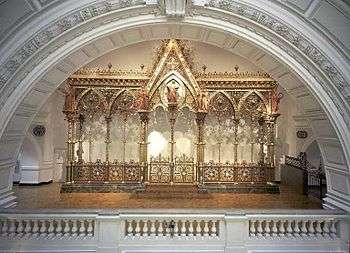
During his lifetime, Francis Skidmore created works for 24 cathedrals, over 300 parish churches, 15 colleges and a number of public buildings.[4][7]
Skidmore, Families of the Bl
ack Country and Birmingham 1600–1900
Some of his more prominent works are detailed below.
Cathedral screens
Lichfield
Between 1855 and 1861 Sir George Gilbert Scott restored parts of Lichfield Cathedral.[8] Francis Skidmore and John Birnie Philip produced the new Victorian metal screen designed by Scott.[9]
Worcester
Between 1864 and 1874 Sir George Gilbert Scott did extensive work in Worcester cathedral, mainly in the choir. Part of this was to commission a screen from Skidmore, installed in 1873 and still in place. It is rather less elaborate than the ones at Hereford and Lichfield.
Hereford
The Hereford Screen was designed by Sir George Gilbert Scott and made by Francis Skidmore.[1] It was made in a period of only four months.[10] To complete such a large and complex structure in only four months, Skidmore took 'short cuts' and used mass production techniques.[11] Skidmore displayed it at the International Exhibition of 1862 where it won a medal for its superior design and craftsmanship.[10]
The screen was dismantled and removed from the cathedral in 1967. The Herbert Art Gallery & Museum in Coventry purchased the screen, but was unable to restore or display it, so in 1983 it was transferred to the Victoria and Albert Museum.[12] Before conservation, the screen was in almost 14,000 individual pieces, many of which were in very poor condition. Conservation of the screen took thirteen months and cost over £800,000 which is, as of September 2011, the largest conservation project undertaken by the V&A.[13] The Hereford Choir Screen is now on display at the V&A.[14]
Salisbury
Sir George Gilbert Scott led the restoration of Salisbury Cathedral between 1863 – 1878. It was during this time that Skidmore created the cathedral's choir screen. In 1959, the screen was removed and most of it was destroyed. The chancel gates survived and are now in the collections of the Victoria and Albert Museum. As of September 2011, they are on display in the Ironwork gallery, room 114a.[15]
Work
- Examples of Francis Skidmore's work
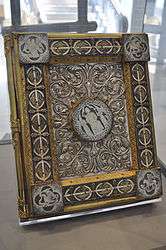 Gilt and enamelled Bible cover, c. 1864.
Gilt and enamelled Bible cover, c. 1864.
HAGAM database ref: H.A.745.12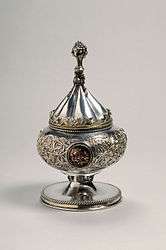 Silver gilt vessel intended for use as a ciborium, c 1845 - 1870.
Silver gilt vessel intended for use as a ciborium, c 1845 - 1870.
HAGAM database ref: H.A.745.3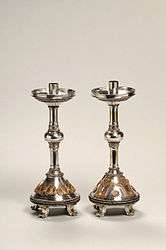 Pair of silver candlesticks, c 1845 - 1870.
Pair of silver candlesticks, c 1845 - 1870.
HAGAM database ref: SH.A.745.2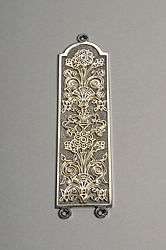 Silver fingerplate, c 1845 - 1870.
Silver fingerplate, c 1845 - 1870.
HAGAM database ref: SH.A.745.5
References
- 1 2 3 4 5 6 7 Jones, Huw and Annette Wickham (2003). Francis Skidmore: A Coventry Craftsman. Coventry Arts and Heritage. ISBN 0-9541185-2-9.
- ↑ "V&A Collections: Chalice". Victoria & Albert Museum. Retrieved 21 September 2011.
- ↑ "Francis Skidmore: Early Years". Herbert Art Gallery and Museum. Retrieved 21 September 2011.
- 1 2 "Historians' Corner, The Art of Francis Alfred Skidmore". The Midland Daily Telegraph. 13 November 1934.
- ↑ "Death of Mr F. A. Skidmore of Coventry". Coventry Times. 18 November 1896.
- ↑ Hopker, Antony (8 February 2000). "Tribute to city metal master; Plaque unveiled to 'forgotten craftsman' who died in poverty". Coventry Evening Telegraph. Retrieved 28 September 2011.
- ↑ Hopker, Antony. "Tribute to city metal master". Francis Skidmore (1816–1896), A Postscript (PDF).
- ↑ "Lichfield Cathedral – The Choir, Presbytery and Sanctuary". Retrieved 20 September 2011.
- ↑ "Lichfield City Council, Places of Interest – Lichfield Cathedral".
- 1 2 Heath, Diana. "The Resurrection of the Hereford Screen, Conservation Journal, Summer 2001 Issue 38". Victoria and Albert Museum. Retrieved 20 September 2011.
- ↑ Aylmer, G. E. and John Eric Tiller (2000). Hereford Cathedral: A History. Continuum International Publishing Group. p. 340. ISBN 978-1-85285-194-1.
- ↑ "The Hereford Screen, by Sir George Gilbert Scott, 1862". Retrieved 20 September 2011.
- ↑ "Conserving the Hereford Screen". Retrieved 20 September 2011.
- ↑ "V&A Collections – The Hereford Screen". Retrieved 20 September 2011.
- ↑ "V&A Collections – Pair of gates". Retrieved 20 September 2011.
External links
| Wikimedia Commons has media related to Francis Skidmore. |
